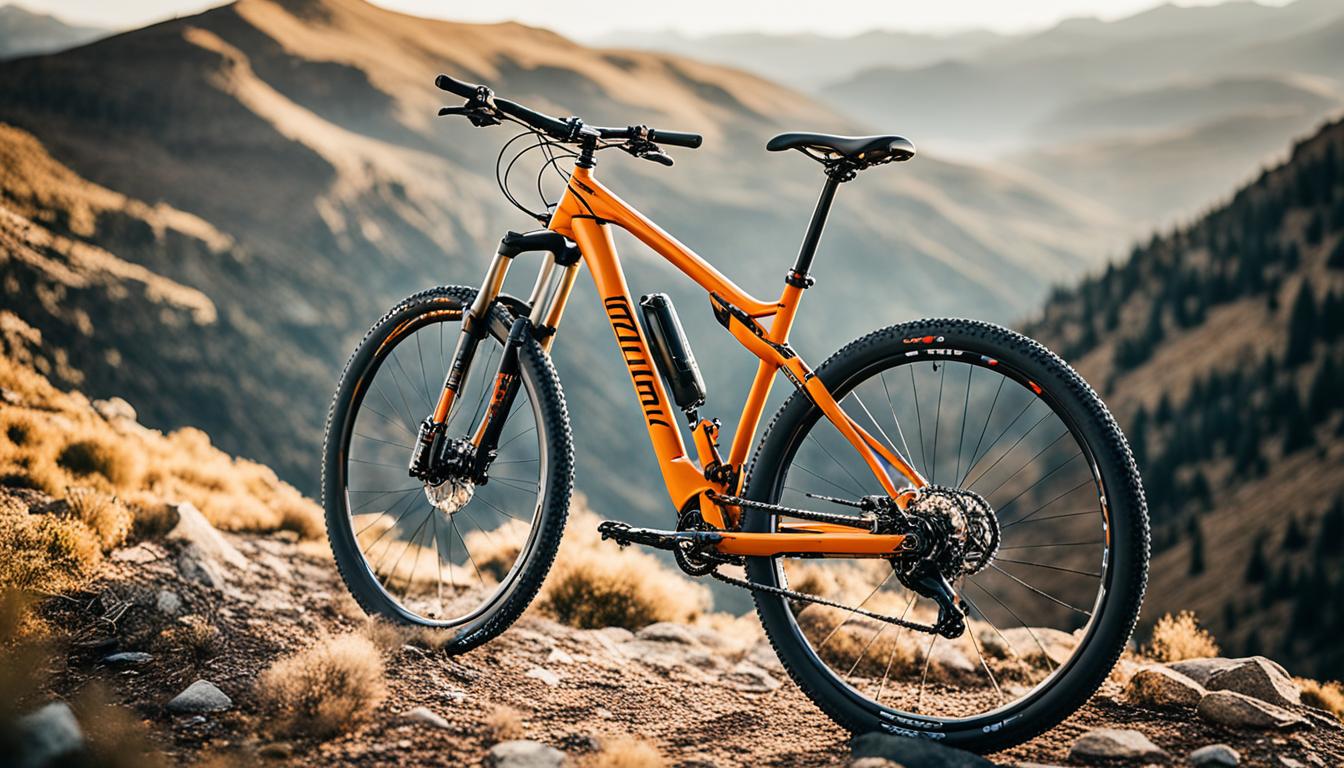Did you know that only a small percentage of mountain bikes come equipped with kickstands? In fact, less than 10% of mountain bikes on the market today have this traditional accessory.
When it comes to mountain biking, kickstands have become a rarity rather than a standard feature. So, what’s behind this shift? In this article, we will explore the reasons why mountain bikes lack kickstands and provide insights into the factors that have contributed to their decline in popularity.
Key Takeaways:
- Kickstands are found on less than 10% of mountain bikes.
- Weight reduction and changes in bike design have made kickstands less practical for modern bikes.
- Safety concerns and potential impacts on bike performance also contribute to the scarcity of kickstands on mountain bikes.
- Alternative options such as bike parking racks, wall mounts, and attachable kickstands provide convenience for parking and storage.
- Individual preferences and market demand play a significant role in the presence or absence of kickstands on bikes.
The History of Kickstands and Their Decline in Popularity
Let’s take a journey back in time to explore the fascinating history of kickstands and understand why they have experienced a decline in popularity. Introduced in the early 20th century, kickstands revolutionized the way cyclists parked their bikes. They offered a quick and convenient solution, allowing riders to prop their bikes up without the need for additional support.
However, as bike designs evolved and became lighter, kickstands started to lose their appeal. The desire for speed and agility led to the development of specialized bike types, such as racing and mountain bikes, which emphasized lightweight construction and aerodynamics. Kickstands were seen as unnecessary add-ons that added weight to the bike, potentially compromising performance.
“The rise of sleek and minimalist bike designs contributed to the declining popularity of kickstands.”
Moreover, advancements in bike technology and materials paved the way for innovative alternatives to kickstands. Manufacturers began integrating features like bike stands, wall mounts, and attachable kickstands into their designs, offering convenience without compromising the bike’s aesthetics or performance.
Despite the decline in popularity, kickstands still remain a beloved feature on certain bike types, such as city, cruiser, and touring bikes. These bikes prioritize utility and convenience, allowing riders to easily park their bikes during commutes or leisurely rides.
As bike design continues to evolve and adapt to the ever-changing needs of cyclists, the role of kickstands may further evolve. Their decline in popularity is a testament to the shifting landscape of bike design, where the pursuit of lightweight construction and sleek aesthetics takes precedence.
In the next section, we will explore why kickstands are rare on mountain bikes, diving into the specific factors that make them impractical for off-road adventures.

Stay tuned for more insights and revelations as we uncover the secrets hidden within the world of bike design.
Reasons Why Kickstands Are Rare on Mountain Bikes
When it comes to mountain bikes, kickstands are a rarity. This is not a coincidence but a result of several factors that make kickstands impractical for off-road adventures. Let’s explore the reasons why kickstands are rarely found on mountain bikes.
1. Design for Off-Road Activities:
Mountain bikes are meticulously designed to tackle rugged terrains and navigate through challenging trails. These bikes prioritize factors such as traction, maneuverability, and shock absorption to provide a smooth and controlled riding experience. Introducing a kickstand would disrupt the bike’s balance and interfere with its performance on demanding trails.
2. Weight Reduction Considerations:
Modern mountain bikes are all about weight reduction. Manufacturers employ advanced materials and innovative design techniques to make bikes as lightweight as possible while maintaining their strength and durability. Adding a kickstand, even a lightweight one, would introduce unnecessary weight that compromises the bike’s agility and responsiveness on the trails.
3. Safety Concerns:
During intense off-road rides, mountain bikers encounter various obstacles and demanding situations. A kickstand could potentially become an obstruction, catching onto rocks, tree roots, or uneven surfaces. This poses a safety risk, leading to potential accidents or damage to the bike.
Overall, while kickstands may be useful for other types of bikes and recreational riding, they are simply not suited for the specific demands and challenges that mountain biking presents. The design focus, weight reduction efforts, and safety considerations all contribute to the rarity of kickstands on mountain bikes.
Kickstand Comparison
| Kickstand Features | Mountain Bikes | City Bikes | Touring Bikes |
|---|---|---|---|
| Design | Focused on off-road performance | Optimized for urban environments | Prioritizes long-distance touring |
| Weight | Minimal weight for agility | Can accommodate slightly heavier kickstands | Weight can be managed due to storage requirements |
| Safety | Potential obstructions and safety risks on trails | Minimal safety concerns in urban settings | Depends on specific touring conditions |
| Convenience | Not designed with immediate parking convenience in mind | Can be more practical for quick stops in urban areas | Useful for extended stops during touring |
As seen in the table above, the design, weight, safety, and convenience factors all vary when considering kickstands for different types of bikes. Mountain bikes, with their focus on off-road performance and weight reduction, simply don’t align with the suitability and practicality of kickstands.

To further illustrate the challenging and dynamic nature of mountain biking, let’s hear from a seasoned rider:
“When I hit the trails, it’s all about agility and control. Having a kickstand on my mountain bike would make it feel clunky and imbalanced. I prioritize weight reduction and ensuring that my bike can handle any obstacle I encounter. I can always find alternative ways to park my bike when I’m taking a break in nature.” – Emily, avid mountain biker
Mountain biking enthusiasts like Emily embrace the absence of kickstands on their bikes, knowing that it allows them to fully immerse themselves in the sport and conquer challenging terrains with ease.
Safety Concerns and Other Reasons Against Kickstands
When considering the use of kickstands on bikes, it’s important to take into account the safety concerns and potential drawbacks they may present. While kickstands can provide convenient parking and storage solutions, they can also pose certain risks and affect bike performance.
Kickstands can pose safety risks if they become loose or dislodged while riding. Imagine cruising down a trail, only to have your kickstand unexpectedly collapse or catch on an obstacle. This sudden instability can lead to accidents, injuries, and damage to both the bike and rider. It’s crucial to prioritize safety and ensure that all bike components, including kickstands, are secure and properly maintained.
Aside from safety concerns, kickstands can also hinder bike performance and handling. On rough terrains and trails, a kickstand can interfere with the bike’s balance and maneuverability. The added weight and potential for the kickstand to catch on obstacles can disrupt the bike’s stability, making it more difficult to navigate challenging terrain. Mountain bikers, in particular, rely on optimal bike performance to tackle rugged trails and maximize their riding experience.
Furthermore, many riders find kickstands unnecessary and prefer the sleeker aesthetic and streamlined functionality of a bike without one. Without a kickstand, bikes can maintain a clean and uncluttered appearance, showcasing their design and performance features without any additional appendages.
While kickstands have their benefits in certain contexts, it’s important to weigh the potential safety concerns and impacts on bike performance, as well as consider personal preferences and the specific needs of your cycling style.

Quote:
“Kickstands can be useful for convenience, but they can also compromise safety and hinder bike performance. It ultimately comes down to personal preference and the type of riding you do.” – Emma Thompson, avid mountain biker
Convenience Alternatives to Kickstands
While kickstands may not be suitable for all bikes, there are several convenient alternatives available that cater to different parking and storage needs. These alternatives provide stability and practicality without the need for a traditional kickstand. Some popular options include:
Bike Parking Racks
Bike parking racks are versatile and ideal for public or commercial spaces. They offer a secure and organized way to park multiple bikes at once. Bike racks come in various designs, such as vertical or horizontal configurations, and can accommodate different types of bikes. With bike parking racks, you can ensure your bike is safely stored while maximizing available space.
Wall Mounts
If you prefer to save floor space and keep your bike indoors, wall mounts are an excellent choice. These mounts securely attach to the wall, allowing you to hang your bike vertically. Wall mounts not only save space but also protect your bike from potential damage. They are particularly useful in apartments, garages, or small storage areas where space is limited.
Bike Stands
Bike stands are another alternative to kickstands, offering stability and convenience for parking your bike. These stands utilize a sturdy base or frame to support the bike, eliminating the need for a kickstand. Bike stands come in various types, including floor stands and portable stands, making them suitable for both indoor and outdoor use. They provide a reliable option for keeping your bike upright and secure.
Attachable Kickstands
If you still prefer the functionality of a kickstand, you can consider attachable kickstands. These kickstands can be easily installed on most bike frames, providing the convenience of a kickstand when needed. Attachable kickstands are adjustable and lightweight, ensuring they do not interfere with your bike’s performance. They are a practical solution for riders who occasionally require a kickstand without permanently attaching one to their bike.
By exploring these alternatives, you can find the perfect solution for parking and storing your bike, regardless of whether a traditional kickstand is suitable for your bike type or preferences.

Installing an Aftermarket Kickstand
For riders who prefer the convenience and functionality of a kickstand, opting for an aftermarket kickstand is a viable solution. When choosing an aftermarket kickstand, it’s essential to select one made of durable materials that can withstand the demands of your biking adventures.
Ensure the aftermarket kickstand is compatible with your bike’s components to guarantee a secure and reliable installation. Different bikes may require specific kickstand designs, so it’s crucial to determine the compatibility before making a purchase.
The installation process for an aftermarket kickstand typically involves locating the attachment point on the bike frame and securing the kickstand using the provided hardware. This attachment point may vary based on your bike’s design, so refer to the installation instructions provided by the kickstand manufacturer for accurate guidance.
Here is a step-by-step guide to installing an aftermarket kickstand:
- Identify the attachment point on the bike frame for the kickstand installation.
- Position the kickstand against the attachment point and align it properly.
- Insert the provided bolts or screws through the kickstand’s mounting holes and into the attachment point.
- Tighten the bolts or screws securely using the appropriate tools, ensuring a stable and reliable attachment.
- Double-check the kickstand’s stability by gently applying pressure to ensure it can support the weight of the bike.
Following these steps will help you successfully install an aftermarket kickstand on your bike, allowing for easy and convenient parking wherever you go.

Preferences and Market Demand
When it comes to kickstands on bikes, personal preferences play a crucial role. Some riders value the practicality and convenience of having a kickstand, while others prioritize the sleek aesthetics and performance of a bike without one. At the end of the day, it’s all about finding the perfect balance that suits each individual’s needs.
Recognizing the diverse preferences of cyclists, bike manufacturers strive to create products that align with market demand. They carefully consider the feedback and desires of riders to ensure their offerings cater to a wide range of individuals. While kickstands may be less prevalent on certain types of bikes, the market still offers various options to cater to different preferences.
Understanding the kickstand preferences of consumers helps manufacturers design and produce bikes that reflect the evolving demands of the market. Whether it’s a sleek and minimalist design or a more practical convenience feature, the continuous research and development in the cycling industry seek to meet the ever-changing needs of riders.
Benefits of Kickstands According to Riders:
- Convenience for quick stops or breaks
- Prevention of scratches and damage to the bike
- Ease of parking without the need for leaning against walls or objects
Benefits of Bikes without Kickstands According to Riders:
- Sleek and minimalist appearance
- Improved bike performance and handling
- Reduced weight for better maneuverability
Customer Testimonial:
“I prefer having a kickstand on my bike as it allows me to take quick breaks without searching for a leaning spot. It’s convenient and saves me from potential scratches on my bike. Plus, it’s always ready to park anywhere!” – Lisa, avid cyclist
Customer Testimonial:
“I love the clean look of my bike without a kickstand. It feels sleek and streamlined, and I have no worries about it hindering my biking experience. I can easily find a secure spot to lean it, so a kickstand is unnecessary for me.” – Mike, passionate cyclist
Market Demand for Kickstands
While kickstands may not be as prevalent on certain types of bikes, such as racing or mountain bikes, there is still a market demand for them. Many riders value the convenience and peace of mind that kickstands offer, especially for urban commuting and recreational riding.
For city, cruiser, and touring bikes where practicality and utility are key, kickstands remain popular. They provide riders with the convenience of easily parking their bikes without the need for additional support or searching for a leaning spot.
Bike manufacturers understand the importance of meeting the demands of their customers, which is why they continue to offer a wide range of options when it comes to kickstands. By providing choices that cater to various preferences, they can ensure that every cyclist finds the perfect bike for their needs.
| Kickstand Preferences | Market Demand |
|---|---|
| Preference for kickstands | Strong |
| Preference for bikes without kickstands | Significant |
| No preference or indifferent | Minority |

As seen from the market demand, the preference for bikes with or without kickstands varies. While there is a strong demand for kickstands, a significant number of riders also prefer bikes without them. This emphasizes the need for bike manufacturers to offer a diverse range of choices to meet the varying demands of consumers.
Scratches, Tears, and Dents from Leaning Bikes
When it comes to parking our bikes, we often find ourselves in search of a suitable spot to lean them against. However, this practice of leaning bikes on various objects can lead to unwanted consequences such as scratches, tears, and dents over time. Constantly relying on random surfaces can be inconvenient and potentially damaging to our beloved bikes.
Instead, one effective solution to avoid these potential damages is to utilize a kickstand. By using a kickstand, we can safely park our bikes without worrying about them leaning against rough surfaces or unstable objects. Not only does a kickstand provide stability, but it also helps preserve the integrity and appearance of our bikes.

| Types of Damage | Potential Consequences |
|---|---|
| Scratches | Unsightly marks on the frame or components |
| Tears | Damage to the seat or other vulnerable parts |
| Dents | Structural damage that affects the bike’s performance |
Avoiding these damages not only helps maintain the aesthetics of our bikes but also preserves their long-term functionality. Whether it’s a leisurely ride around the neighborhood or an exhilarating mountain biking adventure, having a kickstand ensures that our bikes are properly supported and protected at all times.
Additionally, a kickstand provides a sturdy resting place, eliminating the need to search for a suitable leaning spot every time we need to park our bikes. This convenience can save us valuable time and effort, allowing us to focus on enjoying our rides without worrying about potential damage.
Leaning bikes directly on surfaces can cause permanent scratches, tears, and dents. Using a kickstand is a reliable and convenient alternative that safeguards our bikes from unnecessary harm.
By utilizing a kickstand, we can confidently park our bikes without the fear of scratches, tears, or dents. Embracing this simple yet effective accessory ensures that our bikes remain in optimal condition, ready to take us on many more exciting adventures.
Conclusion
After exploring the reasons why mountain bikes often lack kickstands, it is clear that their absence is a result of various factors. The design of mountain bikes prioritizes off-road performance, which means features like kickstands are impractical and potentially unsafe in rugged terrains. Additionally, the constant push for weight reduction in modern bike design has made traditional kickstands less suitable for these lightweight bikes.
However, it’s important to note that kickstands still have their place in the cycling world. City, cruiser, and touring bikes, which prioritize convenience and utility, often come equipped with kickstands. These types of bikes are commonly used for recreational rides and commuting, where the ability to park and rest the bike easily is valued by riders.
The decision to use a kickstand ultimately comes down to personal preferences and individual cycling needs. Some riders may find a kickstand indispensable, appreciating the convenience and ease it provides when parking their bikes. Others may prefer the sleek aesthetic and lightweight design of a mountain bike without a kickstand, prioritizing performance and maneuverability.
In conclusion, while mountain bikes often lack kickstands, their absence shouldn’t discourage riders from enjoying their cycling experiences. Whether you choose to rely on alternative bike parking solutions or opt for an aftermarket kickstand, the key is to find a balance between functionality, safety, and personal preferences to make the most of your mountain biking adventures.









